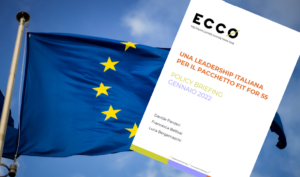The ecological transition is crucial not only for achieving the climate goals contained in the European Green Deal, but also the innovation and industrial competitiveness goals of the Green Deal Industrial Plan. The transition is therefore a prerequisite for growth and thus for debt sustainability. The transition must however be actively supported, because it implies a shift of investment from traditional sectors to others where private finance would not normally invest, in the absence of specific public policies. The investment risk must therefore be partly borne or guaranteed by the public sector in order to create favourable conditions for attracting private investment.
Read the paper “A macroeconomic governance for climate: transition as a prerequisite for growth and debt sustainability” here
Public financing has a key role to play in the transition, so it is important that all Member States are able to deploy the necessary resources, irrespective of the available fiscal space. Significant imbalances in the capacity of Member States to finance the transition would jeopardise the level playing field of the single market.
To date, the debate on the reform of the Stability and Growth Pact and the proposals put forward seem to indicate a lack of political consensus on the creation of the fiscal space for climate investment at the national level. If this is the case, the alternative is for this space to be created at Union level.
One of the possible solutions is the implementation of the European Sovereignty Fund, proposed in the Green Deal Industrial Plan, as a European Climate Fund. This Fund should be linked to the submission of national plans prepared on the basis of the National Energy and Climate Plans (NECPs) and approved by the Commission. These plans should be integrated into the medium-term plans introduced by the reform of the Stability Pact, and this would ensure central control over impacts and results. Not least through the inclusion of robust conditionalities and regular monitoring of the use of funds. Finally, these plans should complement the green transition-oriented measures contained in the National Recovery and Resilience Plans (NRRPs), in order to avoid a duplication of projects and to respond to a real need for funding that cannot be met through existing funds.
A European Climate Fund should cover investment spending, support selective incentives that aim at creating a market for climate-friendly goods and infrastructure, and also ensure the availability of social spending to protect social groups negatively impacted by the transition. Without this, the transition would become much more difficult because the market for zero/low emission goods might not reach the required scale to generate a concrete change in consumption patterns. And the exclusion of the most deprived from the transition would increase social inequalities, social unrest and foster opposition to change. The fund should also have a long time horizon to ensure the policy stability that is a prerequisite for the private sector to invest significantly in the climate transition.
The monitoring of the European Climate Fund plan’s implementation should be integrated into the debt sustainability analysis (DSA) within the Stability Pact. The Commission should also adopt economic models that integrate climate risk by taking into account the work the ECB is already doing in this area.







